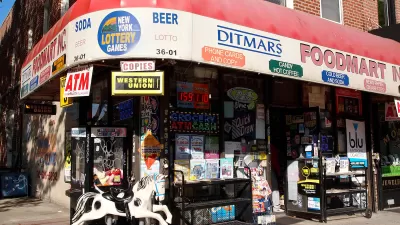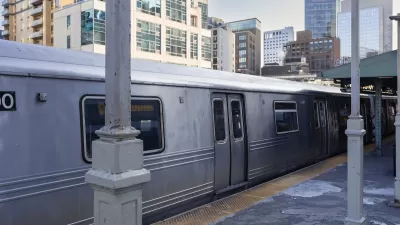Scott Beyer argues that more compact, vertically-oriented cities, like Seattle, San Francisco, Chicago, and Washington D.C., should sell the air rights above public projects.
"Nowadays whenever cities build a central library, to name one example, they usually construct a single-use facility that is only a few stories tall, if that," explains Scott Beyer.
"But what if, before such libraries were built, the air rights -- the undeveloped space above the roofline -- were deregulated and sold off? In expensive and vertically inclined U.S. cities, private developers would pay governments enormous sums for the right to build a high-rise apartment complex or business space above public projects."
The reach of benefits derived from the selling of air rights would reach far beyond single parcels, according to Beyer, and achieve a "broad maximization of public land values, and thus to enormous cash windfalls for local governments."
Beyer cites Boston and New York (Planetizen notes that Atlanta has been making news in recent months for plans to sell air rights above MARTA stations) as cities that sell air rights while acknowledging that most U.S. cities do not: "Walk through any city and you’ll find countless examples of where modestly sized government buildings have been plopped down onto prime real estate. In Seattle, for example, substantial public money has recently gone toward a new library, City Hall and renovated convention center, none of which exceed a dozen stories in an otherwise vertical downtown."
As for why more cities don't make better use of air rights, Beyer lists culprits as zoning regulations, NIMBY opposition, and philosophical barriers within governments.
FULL STORY: Why Don't More Cities Sell Air Rights?

Study: Maui’s Plan to Convert Vacation Rentals to Long-Term Housing Could Cause Nearly $1 Billion Economic Loss
The plan would reduce visitor accommodation by 25,% resulting in 1,900 jobs lost.

North Texas Transit Leaders Tout Benefits of TOD for Growing Region
At a summit focused on transit-oriented development, policymakers discussed how North Texas’ expanded light rail system can serve as a tool for economic growth.

Why Should We Subsidize Public Transportation?
Many public transit agencies face financial stress due to rising costs, declining fare revenue, and declining subsidies. Transit advocates must provide a strong business case for increasing public transit funding.

Dear Tesla Driver: “It’s not You, It’s Him.”
Amidst a booming bumper sticker industry, one writer offers solace to those asking, “Does this car make me look fascist?”

A Visual Celebration of Manhattan’s Chinatown Elder Community, Through Food
Lanterns, cafeteria trays, and community connection take center stage in this stunning photo essay.

How to Make US Trains Faster
Changes to boarding platforms and a switch to electric trains could improve U.S. passenger rail service without the added cost of high-speed rail.
Urban Design for Planners 1: Software Tools
This six-course series explores essential urban design concepts using open source software and equips planners with the tools they need to participate fully in the urban design process.
Planning for Universal Design
Learn the tools for implementing Universal Design in planning regulations.
City of Santa Clarita
Ascent Environmental
Institute for Housing and Urban Development Studies (IHS)
City of Grandview
Harvard GSD Executive Education
Toledo-Lucas County Plan Commissions
Salt Lake City
NYU Wagner Graduate School of Public Service





























